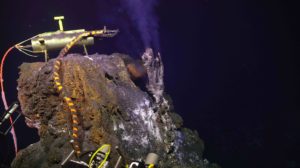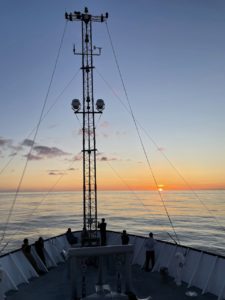We returned to our friend Axial Seamount on Monday, August 18 – the weather and sea gods decided to be kind and we were able to immediately dive once we reached the summit. Many of our initial dives focused on turning a small, cabled substation (junction box) and instruments in the International District Hydrothermal Field on the eastern side of the caldera.
The oval-shaped caldera is a hallmark of Axial Seamount bounded by near-vertical 300 ft walls. Axial sits atop the Cobb hot spot, and Juan de Fuca ridge spreading center and is dissected by it. A northern rift zone extends south into the caldera through CASM, a vent field in a several meter wide, extremely rugged rift, and along a ring fault on the western wall. It’s partner, the southern rift enters the south end of the caldera covered by lava flows and extends along the eastern wall, where the most recent (1998, 2011, and 2015) fissure eruptions have emanated from. This area is the most earthquake active part of the caldera, exemplified by daily maps of seismic activity, with data streaming in live from the RCA seismometers, with data products and plots produced by Dr. William Wilcock at the University of Washington and available to all.
The International District Field is the largest and most active of field in the caldera and as such, hosts the most diverse array of cable instrumentation. During the first two days at the field, we turned the MJ03C junction box that provides power and communication to instruments clustered around a diffuse flow site – Tiny Towers- that also hosts an array of very small, newly formed black smoker chimlets that sprung up last year. Here, we also recovered and redeployed a once of a kind cabled instrument that takes in fluids from diffuse flow sites, storing them into a system that contains a series of 49, sterile gas-tight bags, and another where 24 fluid samples are filtered for DNA and preserved.
Temperatures are taken continuously. In concert, this paired sampling device, known as the RAS-PPS for short, has provided the only data of it kind for a decade – co-registered vent temperatures, vent fluid chemistry and microbial DNA – allowing shore-based scientists to document process linkages among seismicity, vent fluid chemistry and temperature, and changes in microbial community structure over time. A digital still camera looks over the experimental site, highlighting the changes in the vent environment over time.
Bounding Tiny Towers, located in a small depression, are a series of black smoker edifices with name such as Escargot, El Guapo (the handsome one), Pagoda, Top Gun, and Hermosa, and a small chimney called Diva. Two chimneys of note are El Guapo -the largest active vent in the caldera, majestically rising nearly 60 ft above the seafloor and commonly emitting boiling fluids, and Diva -a very small chimney issuing jets of 350°C boiling fluids with extremely high CO2 concentrations. Jason turned an instrument (TRHPH) hosting a wand that is inserted directly into a 330°C orfice at the side of Escargot, which measures temperature and resistivity (an analogue for chlorinity). The highest temperature vents issue fluids that are fresh, leaving the brines in the sub surface.
Following work at the International District, we turned our attention to swapping a junction box and CTD instrument at Eastern Caldera, as site with instrumentation focused on geophysical research and then had a fabulous dive back at the ASHES field. Here, Jason recovered a temperature platform at a small ~330°C black smoker at the base of the ~ 11-12 ft tall Mushroom structure. Mushroom is composed predominantly of metal sulfide minerals, but hosts porous walls such that hydrothermal fluids perpetually leak out of the structure and mix with seawater, forming a high energy environment where chemosynthetic microbial communities, tubeworms sulfide, palm, and scale worms thrive, as well as millions of limpets. The animals are in such abundance that they completely encase the metal sulfide deposit underneath. Deployed last year, the platform had grown an ~ 3 foot tall, beautiful black smoker.
Once we recovered the platform, the cabled high-definition camera was moved back to its original position, allowing spectacular imaging of Mushroom every three hours for anyone in the world to see. We got amazing shots of Mushroom, lit by the HD camera as it ran through its tests to ensure the positioning was well placed to image the entire structure.
Early afternoon on Wednesday, ROV dives were turned over to NSF-funded PI’s Drs. Guangyu Xu and Dax Soule for 3-days of multibeam imaging of vent plumes, installation of multiple stand-alone temperature probes in ASHES, Coguille, International District and CASM hydrothermal fields, and photomosaic surveys. Their work will continue until at least tomorrow August 22.
Onward we go…absolutely phenomenal weather with fin whales and dolphins keeping us company. A true gift they are, and we are grateful for their visits.
- A metal sulfide and anhydrite-rich (CaSO4) chimney sprouts from the side of the Escargot edifice with power and communcation housing on the top. Since 2014, temperatures and chlorinity of the super-heated fluids have been measured with this instrument developed by Dr. M. Lilley at the Univesity of Washington. Credit: UW/NSF-OOI/WHOI; V25.
- A beautiful tubeworm bush thrives on the side of the side of the Mushroom chimney in ASHES. Credit: UW/NSF-OOI/WHOI/ J2-1727; V25.
- Beautiful night at Eastern Caldera with dolphins doing acrobatics in the calm seas and setting sun. Credit: D. Kelley, University of Washington, V25.
Recent Updates


